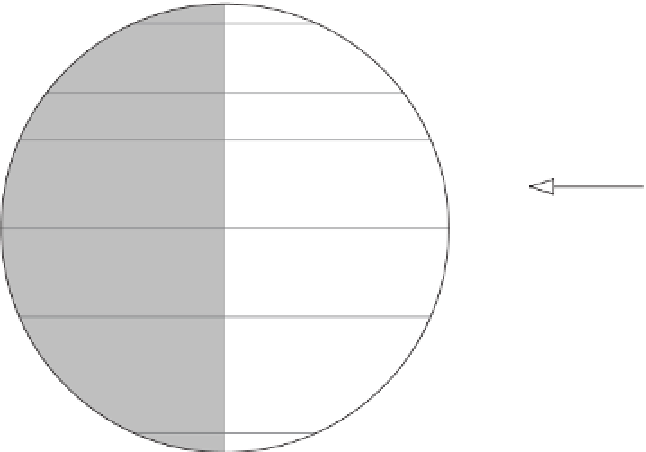Agriculture Reference
In-Depth Information
Earth's rotation
axis
North Pole
Arctic Circle
Solar
rays
66º
South Spain
N
37º
53º
Night
HL
N
23º27'
67º
Tropic of Cancer
HL
N
0º
90º
Equator
HL
HL
Day
67º
N
23º27'
Tropic of Capricorn
66º
South Pole
Antarctic Circle
Fig. 2.5.
The incidence of the solar rays on the earth in the equinoxes. N, Apparent position of the Sun at
noon at different latitudes; HL, horizontal line on each latitude.
Table 2.1.
Duration of the astronomic day
(expressed in hours and tenths of an hour)
depending on the latitude.
warmer the body, the greater the amount of
energy emitted and the shorter the wave-
length of emission (Wien's law, see
Appendix 1 section A.1.4). The Sun, whose
surface temperature is between 5500 and
6000°C, emits short-wavelength radiation,
among which is the light (visible part of
solar radiation). The Sun is very similar to a
'black body', a perfect emitter and receptor
of radiation.
Radiation propagates through space
as a wave, but it also exists as discrete
energy packages called photons. Each
type of radiation propagates in intervals
of different wavelength (which is the
shortest distance between consecutive
waves) and with a determined frequency
(or number of vibrations per second). The
complete set formed by all the wave-
lengths constitutes the electromagnetic
spectrum (Plate 1). The wavelength of a
certain radiation and its frequency are
related, their product being a constant
(see Appendix 1 section A.1.5), thus the
higher the frequency, the lower the wave-
length and vice versa.
Month
Latitude
a
March
June
September
December
52°N
11.6
16.4
12.4
7.6
44°N
11.7
15.2
12.3
8.7
36°N
11.9
14.6
12.3
9.7
a
Latitudes correspond to The Netherlands (52°N), the
south of France (44°N) and the south of Spain (36°N).
of the 'photoperiodic day' for medium
latitudes corresponds to 1 astronomic
day increased by 40 min to 1 h (Berninger,
1989).
2.4
Solar Radiation
2.4.1
Introduction
All bodies emit radiation at wavelengths



















